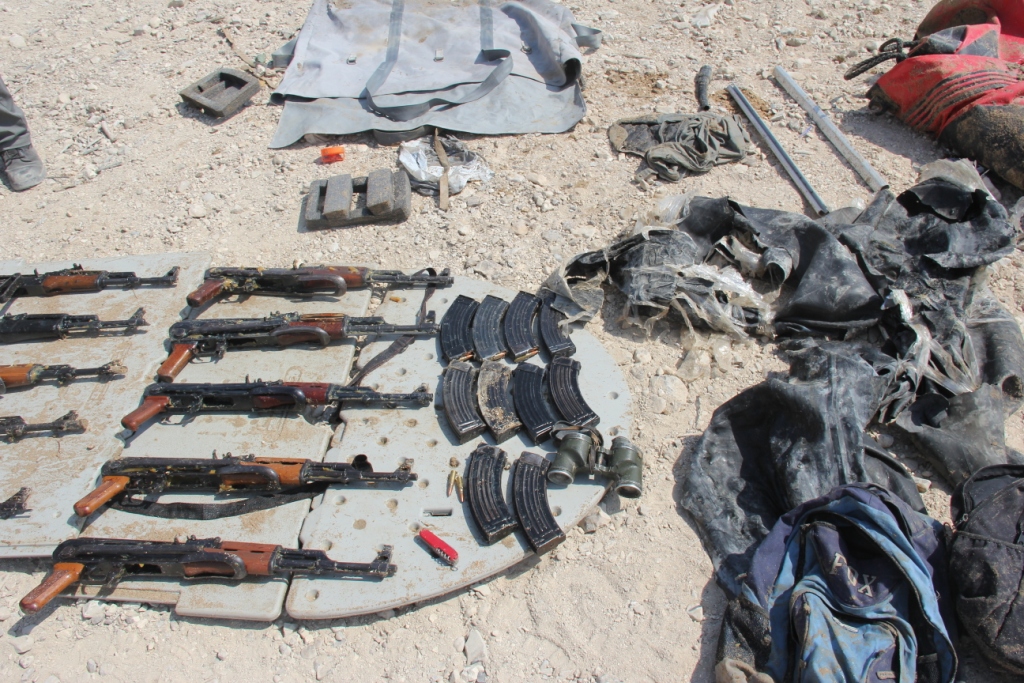A Failed State, Small Boats and Big Money: The Expansion of Somali Piracy and the World’s Response.
By James Bridger.
More Attacks, Higher Costs
Over the course of the past decade, Somali piracy has transformed from a localized nuisance into an international crisis. In 2004, the first response to the growing threat posed by piracy was a warning issued by the International Maritime Bureau (IMB) advising ships to keep 50 nautical miles away from the coast of Somalia. By 2007, the security environment had deteriorated to the point where the United Nations Security Council issued a statement urging naval vessels in the vicinity to take vigilant action to protect shipping. The following year Somali pirates captured international attention when they seized a Ukrainian cargo ship carrying thirty-two Russian tanks and a Saudi tanker holding two million barrels of oil.
Since then the number of attacks has continued to rise. The International Maritime Bureau reported only 44 attempted hijackings emanating from the region in 2007. That number more than doubled the following year. 2010 was the pirates’ most lucrative year: 219 attacks were attempted, 49 vessels were hijacked, and 1186 seafarers were held ransom. It is likely that these figures do not even reveal the full scope of the problem, The International Chamber of Shipping (ICS) estimates that up to 300 pirate attacks go unreported each year in an effort to avoid insurance hikes and reprimands.
An increase in the number of attacks has meant a rise in the global costs associated with piracy. It is estimated that the crime is costing the global economy $7-12 billion annually. This figure includes: the payment of ransoms, the rise in insurance costs, the rerouting of vulnerable ships, and the cost of retooled ship defenses, naval patrols, and prosecution efforts. Maritime nations bordering the Indian Ocean have reported losses in tourism revenue, fishing profits, and docking fees. Piracy has also produced a cost-inflation of basic goods both within Somalia and across the wider region.
Expanded Range
The problems associated with piracy have become increasingly globalized, as the geographical area in which the pirates operate has expanded dramatically. In 2008, Somali pirates were largely contained to the Gulf of Aden, preying on the 20,000 plus ships that passed annually through the chokepoint between Arabia and Africa. As a response to naval patrols however, the pirates have pushed out in every direction: north towards the Red Sea and the coast of Oman, east out into the Indian Ocean, and south down to the Mozambique channel. The ‘risk zone’ for attacks now covers 4 million square kilometers. Jack Lang, a counter-piracy advisor to the UN, warns that the pirates are becoming “the masters” of the Indian Ocean.
Sophistication of Piracy Operations
As it was in the17th century, piracy has become an incredibly lucrative industry in the 21st century. In 2005, Somali pirates ransomed their captured ships for an average payment of $100,000. By 2010, this figure had increased to $5 million. To date, the largest confirmed ransom was the $9.5 million paid for the release of Samho Dream, a South Korean oil supertanker. It is estimated that the pirates took in $240 million in total in 2010.
Large portions of the ransom profits are reinvested in piracy operations, allowing for the mounting of increasingly sophisticated attacks. What began as a “mom-and pop” style endeavor to deter illegal fishing, has transformed into an international criminal enterprise. The larger pirate gangs reportedly have intelligence agents in ports across East Africa and the Middle East. Relayed information about vessels’ cargos, crews, itineraries and defenses allows the pirates to choose targets and plot courses of interception more selectively.
While the selection of targets was originally based on simple opportunism, wealthy gangs now use GPS systems, satellite phones, night vision goggles and ship identification systems to help spot potential victims and coordinate attacks. Piracy was initially restricted to the Gulf of Aden because of the limited range of the small high-speed skiffs used for boarding operations. However, the pirates have extended their geographical domain by using “mother ships,” converted fishing trawlers that can carry five to ten skiffs for more extended ventures.
Demonstrating a heightened level of organizational capacity, in December 2008, a group of more than sixty pirates in twenty skiffs initiated a swarming attack and attempted to hijack five commercial vessels simultaneously. Likewise, the techniques for luring ships appear to have evolved. Pirates have been known to bait their targets using fake distress calls, pose as fishermen or mimic the radio signatures of NATO forces. In an effort to deter naval intervention, hijacked ships carrying oil, gas or hostages are now been used as ‘attack-proof mother ships.’
The Escalation of Violence
The most worrying development in the Somali piracy situation has been the increased use of violence against captives. While hostages had been generally well cared for in the past, the International Transport Workers’ Federation (ITWF) notes that pirates ‘now routinely use death threats, torture and brutality.’ This is part of a larger escalation of violence that has been seen among all parties in the piracy crisis. On January 21, 2001, the South Korean Navy killed eight and captured five pirates when they stormed the Samho Jewelry in a rescue operation. The following month pirates executed four American hostages, allegedly after the US Navy had fired upon them. As one pirate reported to Reuters, ‘it is a fair game that has started, everybody will react if his life is in danger.’ Others claim they want revenge for the over 750 pirates currently captured and awaiting trial. Seeking to explain the rise in violence, Alan Cole of the UN Office on Drugs and Crime (UNODC) contends that it, ‘is to some extent the result of the piracy community changing.’ While the original pirates were former fisherman, new recruits increasingly come from a military background; a large demographic given Somalia’s twenty year civil war.
This violent escalation has not gone unnoticed by the shipping community. A joint campaign has been launched by a variety of multinational shipping organizations and companies to push for tougher international action to be taken against the pirates. Canadian companies have taken part in this “Save our Seafarers” campaign, urging governments to increase their naval presence in the region, target pirates more aggressively, and develop new legal avenues for prosecution. If more concerted measures are not taken, the ITWF warns it will advise members against sailing in the Indian Ocean—an area through which half of the world’s trade passes.
The Response So Far
While it has by no means resolved the crisis, an impressive international counter-piracy effort has been mounted. Vessels and personnel from over two-dozen countries have been involved in patrols and escort duty in the Gulf of Aden and along the Somali coast. There are three major operations: the U.S-led multinational coalition known as Combined Task Force 151 (CTF-151), the EU’s Operation Atalanta, and NATO’s Operation Ocean Shield. Canada has sent frigates to the Indian Ocean three times since 2008 as part of the NATO efforts. The navies of several states, such as Russia, China, Japan, and India are also operating independently. Counter-piracy efforts present a unique opportunity for multinational security cooperation, as pirates have traditionally been known as hostis humani generis—enemies of all mankind.
NATO Commodore Michiel Hijmans has visited the Russian, Chinese, and Indian flagships this year with the intent to better share information and coordinate operations. A high level of international cooperation was seen on January 29, 2011, when a Dutch warship coordinated with an Australian marine patrol aircraft and a Russian frigate to rescue the crew of the merchant vessel New York Star.
The vessels attached to the NATO operation carry out a variety of duties, including: securing convoy routes, escorting ships delivering relief aid, responding to distress calls, and engaging in aerial surveillance. The first submarine used for counter-piracy operations, a Dutch vessel, recently returned from a mission designed to gather intelligence on the movement of pirate mother ships. Coalition vessels have been responsible for the disruption of hundreds of attempted hijackings. Naval actions, coupled with better defensive measures taken by merchant ships, have seen the number of attacks in the Gulf of Aden decrease by more than 50%. However, as has been noted, the piracy problem is not going away—it is transforming into something larger and more dangerous.
Future Directions for Counter-Piracy Policy
Though they have their successes, naval patrols do not address Somali piracy’s root cause. Piracy at sea cannot be disconnected from its bases on land; operations must be financed, captured ships returned to port and lengthy ransom negotiations conducted. The epicentre of Somali piracy is the autonomous region of Puntland. While the country has been described as a ‘failed state’ for almost two decades, Puntland was something of a success story for much of the 1990s and early 2000s. However, governmental overinvestment and ensuing hyperinflation meant that by early 2008 the regional government was no longer able to pay its police force and security militias—leading to the explosion of piracy that same year.
The best option for long-term international counter-piracy policy is a focus on security capacity building programs centered in Puntland. It is only through building up the region’s police, coastguard, and judicial institutions that pirate networks on land can be effectively destroyed. There are promising signs that this strategy is now being pursued. The UNODC has implemented a plan that seeks to bring law and order to Somalia’s pirate prone regions. The first stage has been to build relationships with neighboring countries—such as Kenya and the Seychelles—so that captured pirates receive ‘fair and efficient trials and imprisonment.’ The end goal is to build up the judicial infrastructure of the piracy-prone regions themselves. Local mechanisms for judicial enforcement are essential, as up to 90% of captured pirates are currently let go after their weapons are confiscated, a policy that is disdainfully referred to as ‘catch and release.’
A UN envoy has suggested that special pirate courts and prisons be built in Puntland and the neighboring self-proclaimed independent Republic of Somaliland. Many states currently involved in piracy patrols, such as Denmark, have already pledged funds. However, a plan to build up the capacity of Puntland’s military, police and coastguard forces has not been forthcoming.
Rather than the African Union or NATO, it is the South African private security firm Saracen International that has offered to train an ‘antipiracy army.’ As it lacks any sense of local ownership, this is a worrying development. There have been numerous attempts to hire private counter-piracy forces in Somalia’s past, but none have proven very effective. Many of those trained as coastguards by the British Heart Group in the early 2000s later turned to piracy once the firm left.
A long-term commitment from the international community to build up the security and judicial capacity of Somalia’s pirate-prone regions is needed to bring an end to the problem. The states currently patrolling the Gulf of Aden should transition to this role through cooperation with regional and local partners. This permanent solution is cost effective for NATO members. It is calculated that the cost of keeping one frigate at sea for six months could pay the wages of 100,000 local police for the same period. NATO has already provided capacity building support to the regional states that make up the counter-piracy Contact Group. A concerted effort to increase security and rule of law in the areas from which the pirates emanate is the final step needed to bring calm to the restless seas.
*Disclaimer: The opinions expressed in this article are solely the author’s, and do not represent those of The NATO Council of Canada.





